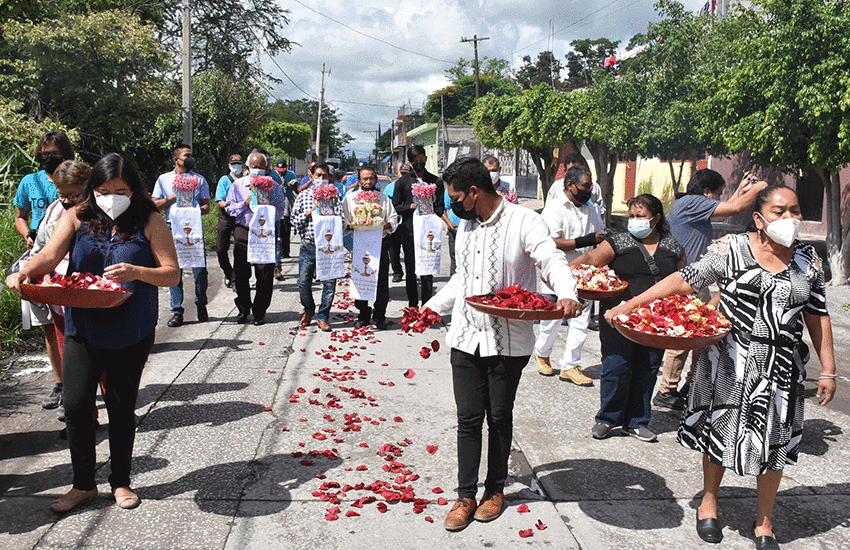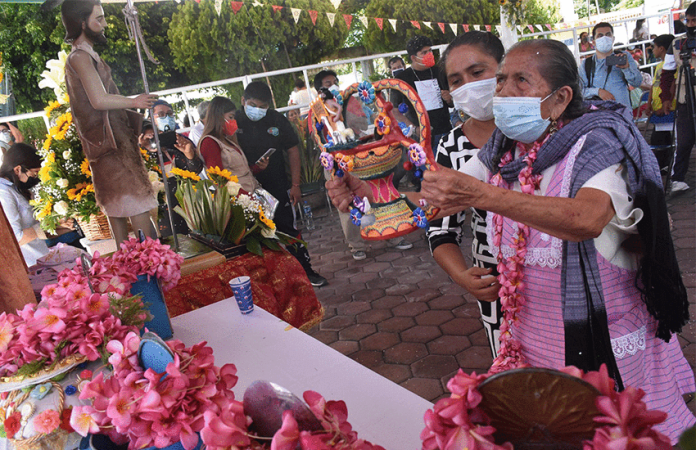On June 29, the streets between the Santa Catarina and the San Juan Coahuixtla neighborhoods in Izúcar de Matamoros, Puebla, were covered with rose petals.
The reason? Every year on that day, the Cofradía de Santísimo Sacramento (Brotherhood of the Blessed Sacrament) installs a new mayordomo or mayordoma (lay religious leader) in a day-long ceremony that begins, as do virtually all such celebrations in Mexico, with a procession.
The Cofradía is one of the most important ceremonies in Izúcar, one that has been held for over 300 years.
“There are many cofradías all over Mexico,” said Raúl Martínez Vázquez, an archaeologist in Izúcar, “but the Cofradía de Santísimo Sacramento is the only one that has lasted since viceregal times. [The Spanish] created it when evangelization arrived.”
Leading this particular procession were two lines of women (dibutadas), each carrying a large tray filled with rose petals. Behind them, a young man laid down a carpet of those petals in front of four men.

Three of the men carried small painted boxes, called alcancías (money boxes).
“These are used to collect money all year to pay for the cost of the fiestas and for the maintenance of the church,” said Jorge Casbal, who has participated in many of these ceremonies.
The fourth man carried the platito, the most important symbol of the event.
“The platito symbolizes the Holy Sacrament, which we venerate with love,” said Josefa Méndez Flores, who was finishing her year as the mayordoma in Santa Catarina.
The platito, a small silver plate, rested on two ornate cushions. Atop it is a small silver circle that represents the host used in Catholic ceremonies related to the Holy Communion.
Although the procession was a solemn one, it was still accompanied by a band belting out popular music.
Izúcar is divided into 14 neighborhoods, with seven in its western part and seven in the eastern, separated by the Nexapa River. The mayordomo in charge of the Cofradía alternates yearly between a western and an eastern neighborhood.
This year, the office passed from Méndez in the western neighborhood of Santa Catarina to Lilia Romero in the eastern one of San Juan Coahuixtla.
Mayordomos and mayordomas across Mexico play an important role in supporting the Catholic Church.
In some neighborhoods in Izúcar, the oldest person, like Méndez, serves as mayordomo, and in others, candidates are asked to serve. In Romero’s neighborhood, “it is not required to be a mayordoma,” she said. “It is voluntary.”
“We agree to serve God. It is a communion between all the neighborhoods and our church. I always dreamed of becoming part of the Cofradía,” Romero explained.
The procession’s first stop was the Santo Domingo Church, completed in 1612, where a Mass was held. Afterward, the procession continued to the entrance to the San Juan Coahuixtla neighborhood, where it was met by the 12 new dibutados, men who will assist Romero during the year, and 12 dibutadas, most of them the wives of the dibutados.
“There are 12 dibutados,” said Méndez, “the same as there were 12 Apostles.”
The dibutados and dibutadas wore white tops and black pants or skirts, and the women had white veils on their heads. “These colors are to show respect for the Cofradía,” said Romero.
The women held trays of rose petals while the men held sahumerios, elaborate incense burners made especially for the event.
María Luisa Balbuena Palacios, a master artisan in Izúcar, has been making the sahumerios for the Cofradía for over 50 years.
“It is an inheritance from my father’s family,” said Casbal, who is Balbuena’s son. “They have made sahumerios for 150 years or more.”
“It is a beautiful tradition because it joins the neighborhoods and it is a commitment to God,” Balbuena said. “It is our belief.”

It takes her almost three months to make the dozen sahumerios used in the ceremony and another two days to paint each one.
The procession continued on, led by the new dibutados and dibutadas, eventually reaching the San Juan Bautista Church, where the platito would be formally received by Romero, the new mayordoma.
The men carrying the alcancías and the platito entered the churchyard and knelt on the concrete floor in front of the church. While people sang an albananza — a song of praise — a dibutada from the San Juan Coahuixtla neighborhood approached, carrying a sahumerio, and knelt in front of them.
“This ceremony is the formal receiving of the platito in the neighborhood,” Romero said. “It is when we commit to serve and work during the year.” The dibutada moved the sahumerio from side to side in front of the men. “The incense is used to purify and sanctify the items,” she added.
Each of the 12 new dibutadas performed this ceremony.
The men then carried the alcancías and the platito to the front and placed them on a small table covered with a white cloth. The dibutados and dibutadas from the Santa Catarina neighborhood approached them individually, each with a sahumerio, repeating the cleansing ceremony.
After this, Méndez placed a garland of cacaloxúchitl flowers on the new dibutados. These beautiful, deep-pink flowers were used by many indigenous groups to decorate their elite members. The plant also has medicinal properties.
The ceremony, which up until that point had been a solemn one, soon took on a much more festive air. The Santa Catarina dibutados hoisted baskets on their shoulders and danced in a small circle.
“The baskets are presents for the new dibutados,” Romero said. “The dance is called the Huincle, or the Dance of the Guajolote (a turkey) — a dance of happiness, of joy. They bring fruit and bread.”
The baskets are given to Romero and the new dibutados, who then also perform the dance. Later, Santa Catarina’s dibutados were given baskets. “I give them a basket with chicken, mole and chocolate,” said Romero.
With presents exchanged, everyone retired under a tent to feast on bean tamales, tortillas and chicken smothered with mole, all paid for and prepared by Romero and her family and neighbors.
“We began the preparation at 4 a.m. this morning,” she said.
She estimated that she had served over 300 people that day, about half the number that typically attended the event pre-pandemic.
Mayordomos in Izúcar serve for a year, and as the mayordoma this year, Romero is making a huge commitment.
During her term, she’ll organize and, in some cases, pay for events during Holy Week next year. In addition to regular Sunday masses, she’ll attend a Mass held every Thursday morning, after which she’ll provide lunch for parishioners. Every Monday and Thursday, she’ll organize the 30 or so people who collect the donations that are used to support the church and then serve them lunch. Family, neighbors and friends will also pitch in.
When asked why she’d take on such a responsibility, she said simply, “It is my faith that moves me.”
Joseph Sorrentino, a writer, photographer and author of the book San Gregorio Atlapulco: Cosmvisiones and of Stinky Island Tales: Some Stories from an Italian-American Childhood, is a regular contributor to Mexico News Daily. More examples of his photographs and links to other articles may be found at www.sorrentinophotography.com. He currently lives in Chipilo, Puebla.
